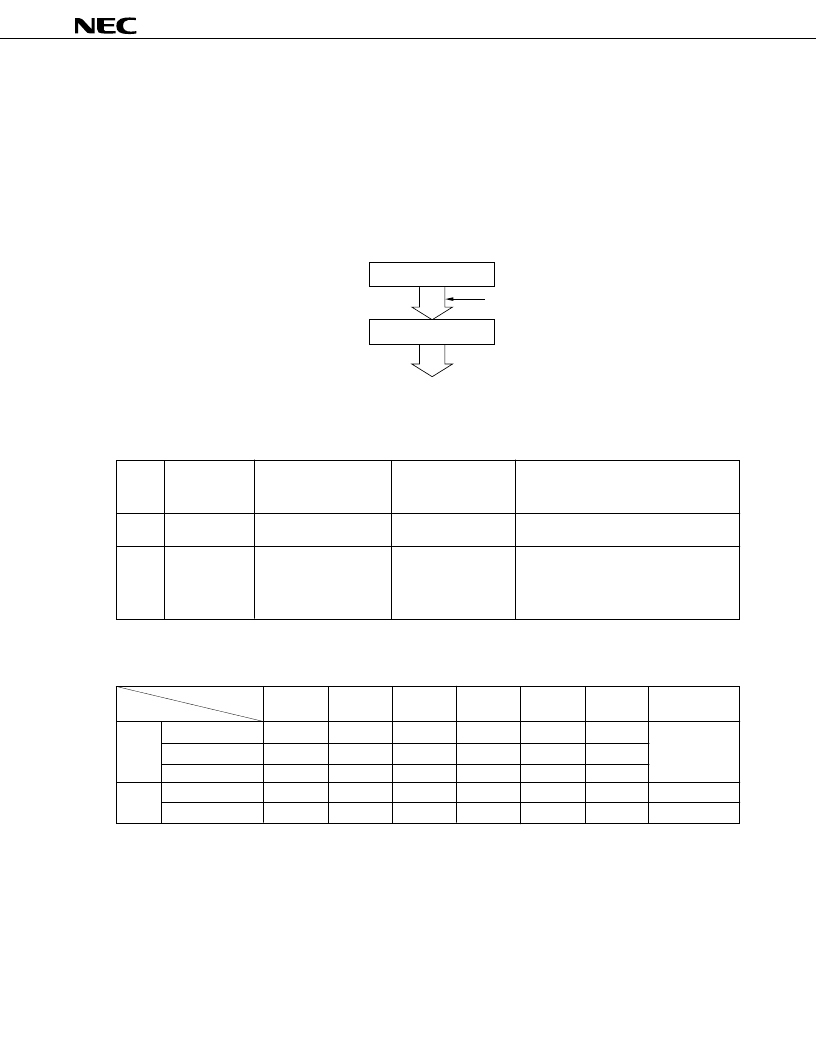- 您現(xiàn)在的位置:買賣IC網(wǎng) > PDF目錄384046 > UPD784915B (NEC Corp.) 16-BIT SINGLE-CHIP MICROCONTROLLERS PDF資料下載
參數(shù)資料
| 型號(hào): | UPD784915B |
| 廠商: | NEC Corp. |
| 英文描述: | 16-BIT SINGLE-CHIP MICROCONTROLLERS |
| 中文描述: | 16位單晶片微控制器 |
| 文件頁數(shù): | 29/86頁 |
| 文件大?。?/td> | 384K |
| 代理商: | UPD784915B |
第1頁第2頁第3頁第4頁第5頁第6頁第7頁第8頁第9頁第10頁第11頁第12頁第13頁第14頁第15頁第16頁第17頁第18頁第19頁第20頁第21頁第22頁第23頁第24頁第25頁第26頁第27頁第28頁當(dāng)前第29頁第30頁第31頁第32頁第33頁第34頁第35頁第36頁第37頁第38頁第39頁第40頁第41頁第42頁第43頁第44頁第45頁第46頁第47頁第48頁第49頁第50頁第51頁第52頁第53頁第54頁第55頁第56頁第57頁第58頁第59頁第60頁第61頁第62頁第63頁第64頁第65頁第66頁第67頁第68頁第69頁第70頁第71頁第72頁第73頁第74頁第75頁第76頁第77頁第78頁第79頁第80頁第81頁第82頁第83頁第84頁第85頁第86頁

μ
PD784915B, 784916B
29
3.5 Real-time Output Port
A real-time output port consists of a port output latch and a buffer register (refer to
Figure 3-5
).
The function to transfer the data prepared in advance in the buffer register to the output latch when a trigger such
as a timer interrupt occurs, and output the data to an external device is called a real-time output function. A port used
in this way is called a real-time output port (RTP).
Table 3-4 shows the real-time output ports of the
μ
PD784916B.
Table 3-5 shows the trigger sources of RTPs.
Figure 3-5. Configuration of RTP
Table 3-4. Bit Configuration of RTP
Table 3-5. Trigger Sources of RTP
Trigger Source
INTCR00
INTCR01
INTCR02
INTCR13
INTCR50
INTP0
Remark
RTP
RTP0
High-order 4 bits
√
Low-order 4 bits
√
√
All 8 bits
√
√
RTP8
Bit 0
√
√
√
√
Note 1
Bits 2 and 3
√
Note 2
Notes 1.
Select one of the four trigger sources.
2.
When the real-time output port mode is set by the port mode control register 8 (PMC8), the HASW and
ROT-C signals that are set by the head amplifier switch output control register (HAPC) are directly output.
The HASW and ROT-C signals are synchronized with HSW output (TM0-CR00 coincidence signal).
However, the set signal is output immediately when the HAPC register is rewritten.
RTP
RTP0
RTP8
Remark
—
Pseudo V
SYNC
output : 1 channel (RTP80)
Head amplifier switch : 1 channel (RTP82)
Chrominance rotation signal output: 1
channel (RTP83)
Alternate
Function
Port 0
Port 8
Number of Bits of
Real-Time Output Data
4 bits
×
2 channels or
8 bits
×
1 channel
1 bit
×
1 channel and 2
bits
×
1 channel
Number of Bits That
Can Be Specified as
RTP
4-bit units
1-bit units
Buffer register
Port output latch
Port
Output trigger
相關(guān)PDF資料 |
PDF描述 |
|---|---|
| UPD784915BGF | 16-BIT SINGLE-CHIP MICROCONTROLLERS |
| UPD784916B | 16-BIT SINGLE-CHIP MICROCONTROLLERS |
| UPD784916BGF | 16-BIT SINGLE-CHIP MICROCONTROLLERS |
| UPD799 | 2048-BIT CCD IMAGE SENSOR |
| UPD8251A | PROGRAMMABLE COMMUNICATIONS INTERFACE |
相關(guān)代理商/技術(shù)參數(shù) |
參數(shù)描述 |
|---|---|
| UPD784935AGF-113-3BA | 制造商:NEC Electronics Corporation 功能描述: |
| UPD784938AGF-188-3BA | 制造商:NEC Electronics Corporation 功能描述: |
| UPD789104AMC(A)-968-5A4-E2 | 制造商:Renesas Electronics Corporation 功能描述: |
| UPD789104AMC-671-5A4-E1 | 制造商:Renesas Electronics Corporation 功能描述: |
| UPD789104AMC-672-5A4-E1 | 制造商:Renesas Electronics Corporation 功能描述: |
發(fā)布緊急采購,3分鐘左右您將得到回復(fù)。